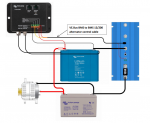That relay would work. A battery is a battery, LFP has a lower internal resitance, so it can accept higher charge rates at the same voltage. Nothing magical about doing some quick math with resistance and voltage drop to find the desired max charge rate. That is what you are doing, is setting the max charge rate. That is determined by testing at idle. The system is self balancing, as alternator temperature, and the batteries acceptance rate provide feedback. Since you wouldn't be using a DC-DC you are limited in how much tuning you can do anyways.
Here is how I would approach the alternator charge design. I would contact victron and ask for charge rate vs charge voltage plots. Say for 13.5 to 14.4V, you are looking for the plot that has the sustained current (5 minutes or more) which is under the anticipated alternator max output at idle. Most alternators can make 80% of their rated current at idle. Subtract 40-60A for engine/lights/fans. The remainder is you estimated max current. Lets say 100A.
Look at victrons plots, lets say that 13.5V results in a max sustained current of 90A. Now we have the V and I, so we can calculate the R. V=I*R. V= Alternator voltage minus 13.4V. Assuming an alternator voltage of 13.9V 0.5=90*R so R= 5.5 milliohms.
Assuming a wire run of 20ft round trip you would want to use 1AWG which yields 2.5 millohm. Assuming 1 milliohm from connections, and another 2 from the fuses, you will effectively limit the current. You can fairly easily swap in a smaller fuse (say 100A instead of 150A) to fine tune the max current.
Most folks don't mention this, but automotive alternators are self limiting. When the field current hits its max (usually around 10A), the alternator will not produce any more output current. Increasing the load simply drops the alternators output voltage until equilibrium is met.



